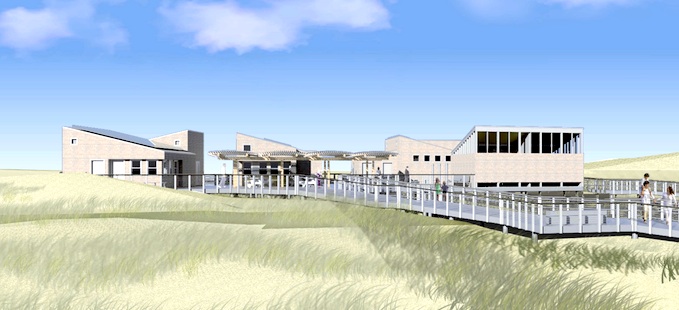Hurricane Sandy and the Blizzard of '13 are history, but in their wake National Park Service managers are rebuilding with an eye on more of the same potent storms in the years ahead. At Cape Cod National Seashore, that also means keeping sea level rise in mind.
Seashore officials currently are putting the final touches on a draft environmental assessment for rebuilding the Herring Cove beach facilities near the north tip of Cape Cod. There along the shore a bathhouse, parking area, and concession stand have stood since the 1950s when they were built by the Commonwealth of Massachusetts.
But wave action in late December 2012 caused damage to the asphalt seawall near the bath house and sections of the north parking lot, and coastal areas near the south parking lot. As the Park Service works on replacement facilities, officials are keeping climate change and its related impacts in mind.
"The first phase we had to replace a bathhouse that was there, built by the state in the 1950s," says Cape Cod Superintendent George Price. "It was very much a cement blockhouse facility, two stories, about as unattractive architecture as you could possibly imagine. And it was actually built in a bunker style as a lesson from the hurricane of 1938, which wiped out all kinds of facilities in the Northeast."
While the design was drafted in the 1930s, the plan was stalled by World War II and not revived until the 1950s.
"They took that design that they had off the shelf, and that’s what they constructed at a lot of their beach facilities," Superintendent Price said.
While the facility served its purpose for decades, it finally began to crumble under time and the elements. Sea water was undermining the facility, notes the superintendent, and spalling off concrete created gaps wide enough that "you could actully see cracks right up from the macadam through the walls to the ceiling of the building," he said.

Facilities proposed for Herring Cove were designed with climate change in mind. NPS rendering.
The facility proposed to replace this bunker has been pushed farther back from the shoreline, and placed on four-foot pilings. Too, the buildings will be modular units in style.
"Not looking like a mobile home at all, but structures that are being constructed to the point where they could actually be lifted by a crane and relocated," said Superintendent Price.
Though not the first unit of the National Park System to consider facilities that can be moved in the face of storms -- Everglades National Park is experimenting with tent lodging at Flamingo this year, and Assasteauge Island National Seashore has movable restroom facilities -- Cape Cod National Seashore officials are working on a larger scale than either of those projects.
"These are actually much more substantial. Room-sized structures for changing rooms, restrooms, concessions, etc.," said Superintendent Price.
Along with the bathhouse facility, which will also hold concessions and lockers for lifeguards, parking areas are being designed to provide visitors with sweeping views of both Herring Cove and Cape Cod Bay.
"There’s a parking lot where you can still park and look directly out to the water (bay side) which is a very important value for visitors because you can directly right off the coast there see whales, and some of them are pretty close in," the superintendent said. "It’s actually where the bay and the ocean join up at the very tip of Provincetown. I myself have counted ten whales at one time that I’ve seen from my car.”
Last December's storm tore into the parking area and damaged the seawall (also known as a revetment), and left seashore officials at the drawing board.
"We did some patches, but we’re in the process of trying to figure out what our alternative will be for the future. So we’re in the process of working with our advisory commission in exploring some alternatives that can still give us some substantial visitor value and yet be sustainable over time," said Superintendent Price. "How can we pull it back, how can we still have people view the ocean, and how can we still have somewhat of a natural beach with shoreline processes."
A draft proposal is expected later this summer, with a possible final plan arriving late this year.



Add comment